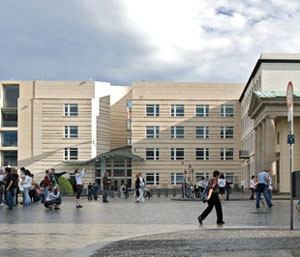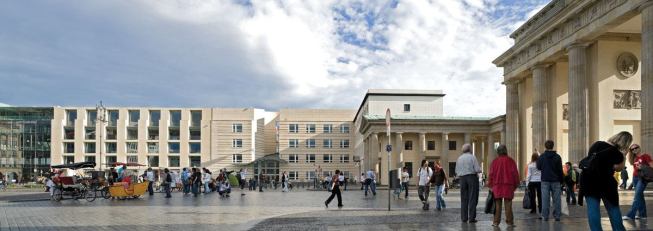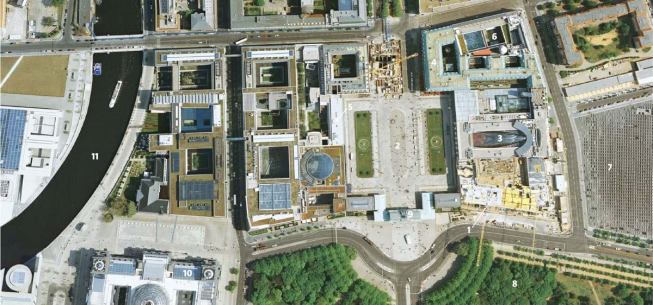Tomas Riehle
The open-roofed courtyard features that fetish of every American homeowner, a pristine green lawn. In its midst stands an Ellsworth Kelly sculpture, a totem of pearly gray stainless steel that draws a vertical line from the garden to the sky. The courtyard landscaping by the Olin Partnership uses American species like pine, dogwood, and cypress. A stone-paved outdoor terrace with a high Colorado sandstone fireplace and walls makes this an inviting space for the embassy’s annual July 4 barbecue.
Inside there is a communal dining area, with another stone hearth that recalls a Western lodge or the interior of a Neutra house. George Nelson “bubble lamps” and molded plywood chairs by Charles and Ray Eames lend an air of ease within a diplomatic fortress built to withstand assault from the outside. Ruble declined to discuss security features of the blast-resistant building and asked me to move away when I began to examine the thick steel window frames in a conference room facing the Pariser Platz.
The building’s most prominent element—a round tower housing the ambassador’s offices—is not visible from Pariser Platz. But it looms large when one looks at the embassy from the other side of the Brandenburg Gate. The tower, topped in the competition scheme by a rounded copper cupola that harkened to the lamp atop the Statue of Liberty, has ended up encased in a rectangular steel trellis that lends it more the aura of a battleship plowing full steam ahead. According to Ruble, the trellis is intended to relate to the classical lines of the gate.
Only higher ranking visitors will ascend via elevator to this rarefied precinct. The ambassador’s office has views out over the Tiergarten and is furnished with Bauhaus pieces, in tribute to the host nation. The most spectacular interior space is the adjoining round “stateroom,” where 20 Brno chairs encircle a massive round table that is embedded with a compass to imply the charting of a course for diplomacy. Curved glass walls open onto a rooftop terrace with a parterre garden of American grasses. The stateroom looks out onto the dome of the Reichstag and the top of the gate, with its bronze quadriga statue of a winged goddess driving a four-horse chariot.
This vista will make Germany’s chancellor, whose own offices are on the other side of the parliament building, green with envy. “I want you to give me the best place to have lunch in Berlin,” Charles Redman, who served as ambassador when the embassy design was chosen, asked Ruble and his partners. Redman’s successors certainly have that coveted spot in this jaw-dropping room.
Providing such a spectacular spot for official entertaining is a praiseworthy goal for an embassy architect, but so is providing an enticing image for the building as a whole. Relatively few Germans will ever enjoy the spectacular view from the tower; many will experience the dull exterior façades, which rely on white brise soleils poised over aluminum window frames to provide detail.
In their assessment of this thorny commission, German critics were clearly blinkered by antipathy to the current U.S. government. Still, while it’s unfair to condemn this building as an emblem of American decline in the era of George W. Bush, devising secure U.S. embassies of architectural distinction is not yet a mission accomplished.
Critic Michael Z. Wise is the author of Capital Dilemma: Germany’s Search for a New Architecture of Democracy.


